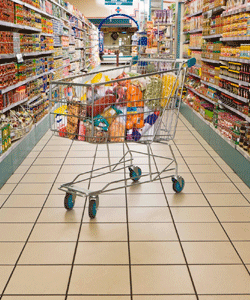The nefarious ways of the modern-day supermarket apparently are widely known. The journalist Jack Hitt, writing in The New York Times Sunday Magazine in 1996, detailed numerous tricks grocers use to make us buy food we don’t want or need, such as playing slow tempo music and using “cunning” product placement on shelves.
Marion Nestle, a professor of nutrition and food studies at New York University, writing in her book What to Eat, notes the “breathtaking amounts of research” that seems to have gone into designing supermarkets. “There are precise reasons why milk is at the back of the store and the center aisles are so long. You are forced to go past thousands of other products on your way to get what you need.”
Plug “supermarket design research” into your Internet search field and you will see a National Geographic blog titled “Surviving the Sneaky Psychology of Supermarkets,” and two from Business Insider, “15 Ways Supermarkets Trick You Into Spending More Money” and “A Few More Ways Supermarkets Mess With Your Minds.”
“Grocery shopping, start to finish,” writes Rebecca Rupp on the National Geographic site, “is a cunningly orchestrated process. Every feature of the store—from floor plan and shelf layout to lighting, music, and ladies in aprons offering free sausages on sticks—is designed to lure us in, keep us there, and seduce us into spending money.”
They put produce up front because fruits and vegetables, Rupp writes, “makes us feel upbeat and happy,” and the vegetables are misted to make them look deceptively dewy and fresh-picked, when, in fact, the water simply speeds rot.
I found these items while researching my latest book, Grocery: The Buying and Selling of Food in America, for which I spent a year at small Midwestern supermarket chain (twenty-three stores, $600 million in sales is considered small) called Heinen’s, owned and run by two brothers of that name, grandkids of the founder.
Two things struck me as odd during my reporting. First, none of these journalists, not even the writer for the Times, seemed to have asked a grocer for a response or given them a chance to deny the claims or justify their sneaky ways. And two, after more than a year hanging around grocers, spending hours in their stores (I even bagged groceries), traveling the country with them, I saw no grocers rubbing their hands with malevolent glee at new ways to trick the customer or mess with their minds.
One grocer even got preemptively mad at me, before I’d even opened my mouth.
“You know what really bugs me?” asked Mark Skogen, head of Festival Foods in Wisconsin, as we toured a group of stores in New Jersey.
“What’s that?” I said.
“That silly knock that a grocery store gets over the years. Some knucklehead journalist comes in and says, ‘This is how you need to be careful in a grocery store. You know they put the milk in the back on purpose. You’ve got to go all the way back to get this popular item.’ Who says milk is the most purchased?”
“There’s no science or trickeration,” he said, “other than just a nice easy flow through the store. Our stores are just logical.” He concluded: “You want to know why dairy is in back? Because that’s the most efficient place to put these huge refrigerated cases.”
Jeff Heinen addressed every one of the ways people commonly assume they are tricking you (misting vegetables keeps them from drying out from all the refrigerated air blowing over them; the managers pick whatever music the employees want; they don’t charge slotting fees for prominent placement of goods; they don’t rely on scientific studies in stocking shelves; and so on). “The fact is that the customer’s drive for ever-lower prices means the retailer does not even have time to overthink all these issues,” Heinen told me. “Heinen’s carries 40,000 items, and we barely have time to tie our shoes, let alone try to psychologically outsmart our customers.”
The real secret of the modern-day supermarket is what a remarkable creation it is. A retail store filled, as never before in its history, with an astonishing array of delicious, nutritious, inexpensive food. Yes, it’s filled with crap food that will make you sick over time, if you choose to eat such food. Supermarkets are a marvel, an unprecedented achievement, an astonishing food surplus, all the world’s food bounty under one roof, 38,000 of them spread across this country and, for most of us, just a short drive away.
And we scarcely give them a thought, except to ask how is it they’re trying to trick us.
Ruhlman ’85 has written more than twenty books, mostly on topics related to food and cooking, and contributed to publications like The New York Times, The Washington Post, and The Los Angeles Times.

Share your comments
Have an account?
Sign in to commentNo Account?
Email the editor